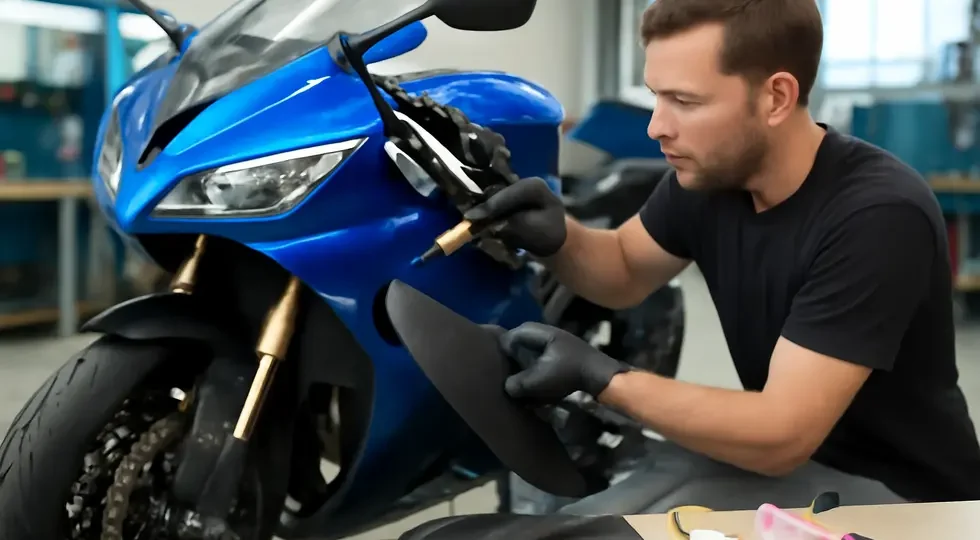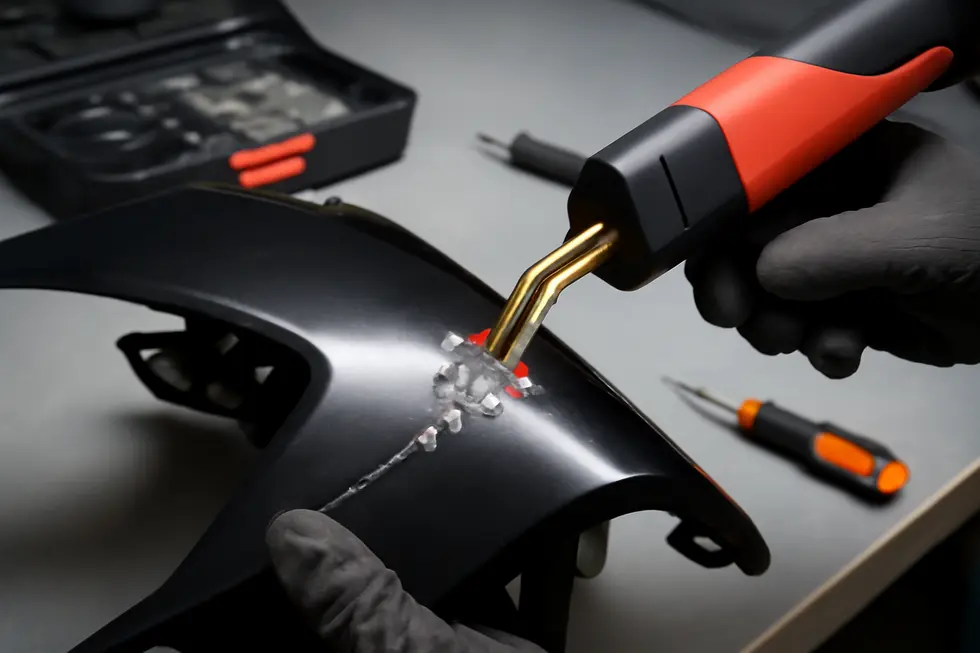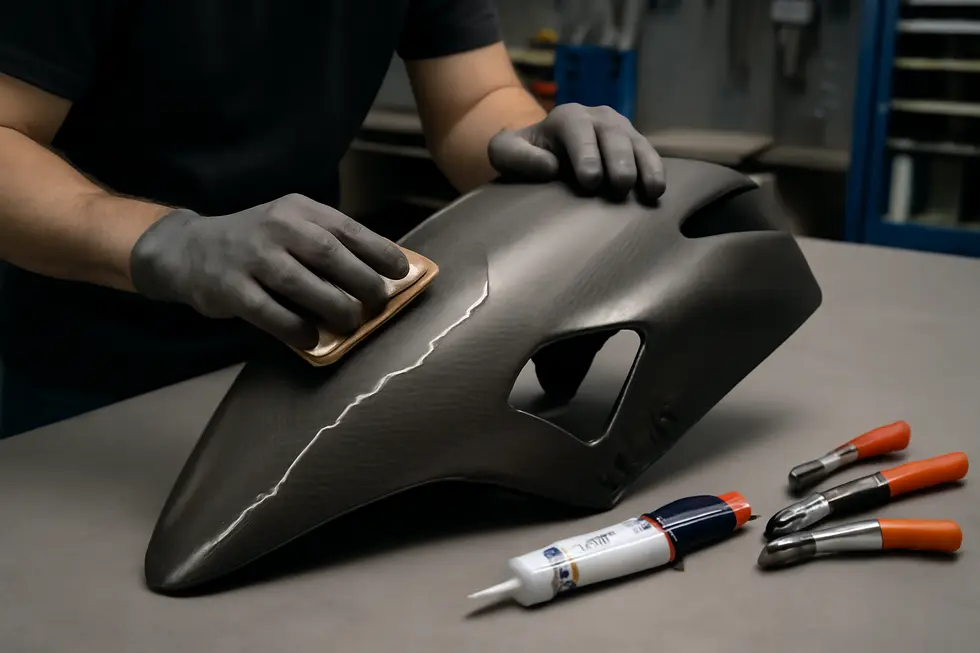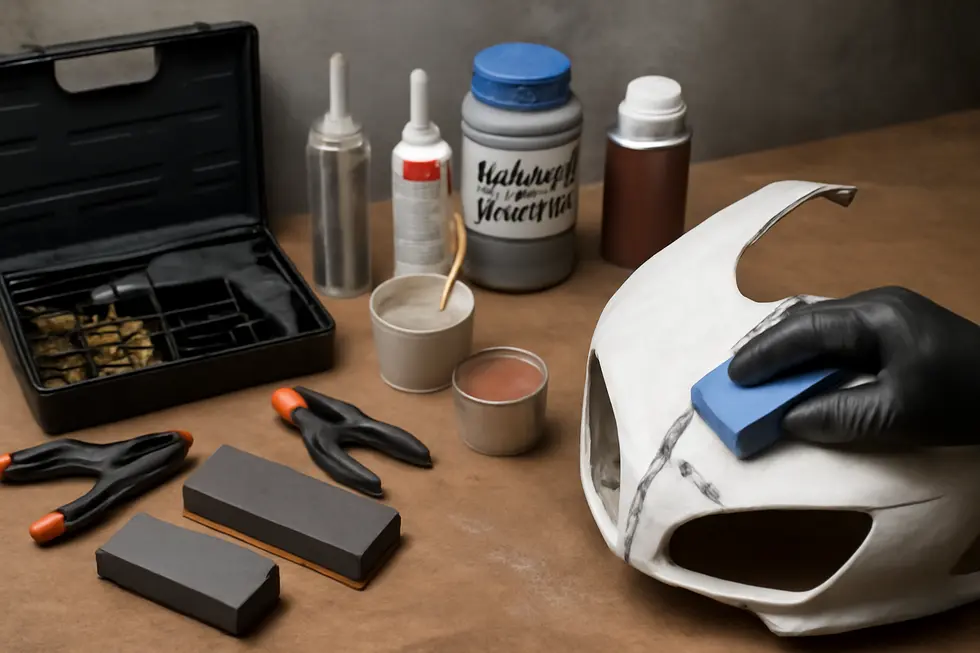How to Repair Cracked Motorcycle Fairings: Essential Techniques for Business Owners
September 25, 2025 | by summitfairings

Introduction
Motorcycle fairings are crucial for both the aesthetics and aerodynamics of a bike, but their exposed nature makes them vulnerable to cracks and damage. For business owners managing repair shops or aftermarket parts services, mastering the repair of cracked motorcycle fairings can enhance service quality, customer satisfaction, and profitability. This guide breaks down core approaches for repairing the two major types of fairing materials: plastic and carbon fiber. The first chapter focuses on plastic fairings, detailing the specialized welding techniques and materials that restore strength and appearance. The second chapter addresses the unique methods required for carbon fiber repairs, emphasizing proper surface preparation and epoxy resin application. Finally, the third chapter outlines best practices, necessary tools, and finishing touches to ensure professional, durable repairs. Understanding these methods empowers businesses to deliver reliable, high-quality fairing restoration services tailored to material specifications.
Tables of Contents
Chapter 1: Mastering Plastic Fairing Repairs: Essential Techniques for Durable Cracked Repairs
- Crucial Preparation and Cleaning Strategies for Effective Plastic Motorcycle Fairing Repairs
- Essential Adhesives and Repair Materials for Durable Plastic Fairing Restoration
- Mastering the Art of Sanding, Finishing, and Painting for Durable Plastic Fairing Repairs
Chapter 2: How to Repair Cracked Motorcycle Fairing: Carbon Fiber Fairing Repair Procedures
- Understanding Material Science and Technology for Effective Carbon Fiber Fairing Repairs
- Balancing Quality and Cost: Economic Insights into Carbon Fiber Motorcycle Fairing Repairs
- Balancing Sustainability and Rider Safety: The Societal and Environmental Dimensions of Carbon Fiber Fairing Repairs
Chapter 3: How to Repair Cracked Motorcycle Fairing: Best Practices, Tools, and Post-Repair Finishing
- Mastering Preparation and Structural Reinforcement for Durable Motorcycle Fairing Repairs
- Essential Tools and Materials: Foundations for Durable Motorcycle Fairing Repairs
- Mastering Post-Repair Finishing to Restore Strength and Aesthetic of Cracked Motorcycle Fairings
Chapter 1: Mastering Plastic Fairing Repairs: Essential Techniques for Durable Cracked Repairs

1. Crucial Preparation and Cleaning Strategies for Effective Plastic Motorcycle Fairing Repairs
The foundation of any successful plastic motorcycle fairing repair lies in thorough preparation and meticulous cleaning. These initial steps are critical to ensure the repair materials adhere securely and the crack is permanently stabilized. Before applying any welding or filler material, the affected area must be completely free from dirt, grease, and contaminants. Using a strong degreaser or paint thinner effectively removes oils and grime that could compromise bonding strength. This cleaning step guarantees that adhesive elements like plastic welding rods or resin will fuse deeply and firmly to the surface.
Following cleaning, lightly sanding the cracked zone is indispensable. Sanding creates a slightly roughened surface across the break, enhancing mechanical adhesion without causing further weakening. Medium to fine grit sandpaper is ideal for balancing sufficient texture with a controlled finish. This subtle abrasion eliminates loose fragments and primes the plastic for better integration with repair fillers.
For many plastic fairings, particularly those susceptible to fatigue, forming a shallow V-shaped groove directly along the crack line further improves repair strength. This groove allows repair compounds to fully penetrate and fill the crack’s depth, sealing it internally and reinforcing the fragile edges. The V-groove technique helps distribute stress more evenly and reduces the likelihood of crack recurrence.
Equally important is carefully inspecting the entire damaged area to remove any loose plastic shards or fibrous strands that could hinder the repair process. A stable, clean base is essential before bonding materials are applied. Neglecting these preparation steps reduces the durability of the repair and risks premature failure under the rigors of riding conditions.
In practice, these cleaning and preparation steps are standard prerequisites whether you proceed with plastic welding, resin application, or patching methods. Their consistent application ensures that the subsequent repair materials behave as intended, producing resilient, professional-quality results. For those seeking deeper insights into fairing repairs using these preparation fundamentals, exploring detailed guides on motorcycle fairing options can be invaluable and is available at this comprehensive motorcycle fairings resource.
2. Essential Adhesives and Repair Materials for Durable Plastic Fairing Restoration
Repairing cracked plastic motorcycle fairings demands the careful selection of adhesives and materials that ensure both lasting strength and a seamless finish. Among the most reliable options, specialized plastic adhesives stand out for their strong bonding capacity and ease of application. These adhesives create durable repairs by chemically fusing with the plastic substrate, making them ideal for addressing everything from minor cracks to more significant breaks without adding bulk.
For larger or more complex damages, reinforcing the affected area with fiberglass resin and cloth is a trusted method. This combination rebuilds structural integrity where simple adhesives fall short. The resin saturates the fiberglass cloth, which when applied over the crack, forms a rigid layer that supports the fairing’s shape and load-bearing ability. Following this reinforcement, plastic fillers or glazing compounds can be used to smooth out surface imperfections, preparing the area for high-quality primer and paint.
Plastic welding kits offer an alternative repair approach, especially effective for fine cracks. By melting the plastic edges and fusing them directly, this method eliminates the need for additional bonding agents and closely restores the fairing’s original strength.
Critical to the success of any adhesive or material application is thorough surface preparation. Removing dirt, grease, and old paint from the damaged area ensures maximum adhesion. Techniques such as sanding or creating a shallow V-groove along the crack can substantially increase bonding by enlarging the contact surface.
After bonding and reinforcement, using appropriate sanding tools to blend repair materials smoothly is essential before applying primers designed for plastic surfaces. These primers assist in creating a uniform base that enhances paint adhesion and finish quality.
For riders seeking expert advice and video demonstrations on applying these materials effectively, exploring detailed repair tutorials offers invaluable practical insights. To learn more about selecting the right fairings to complement your repaired plastics, visit our comprehensive guide to affordable motorcycle fairings.
3. Mastering the Art of Sanding, Finishing, and Painting for Durable Plastic Fairing Repairs
When repairing cracked plastic motorcycle fairings, the sanding, finishing, and painting phases are crucial for restoring both durability and visual appeal. After the adhesive or filler has fully cured, begin by sanding the repaired area to blend it smoothly with the surrounding surface. Using fine-grit sandpaper, create a uniform texture that eliminates excess filler or rough patches while maintaining the fairing’s original contours. This careful smoothing ensures the repair won’t be noticeable once painted.
Following sanding, the finishing process often involves applying a lightweight body filler to address minor imperfections left behind. Once applied and cured, this filler is sanded flush to achieve a seamless surface. Proper surface preparation at this stage is vital; any debris or unevenness can affect paint adhesion and final appearance.
Before painting, thoroughly clean the surface to remove dust and oils without harsh chemicals that could interfere with primer bonding. Applying a primer formulated specifically for plastics or fiberglass creates an ideal base, enhancing paint adhesion and preventing peeling. Once primed, base coats are applied meticulously, often in multiple thin layers to build consistent color and depth.
The final steps include applying clear coats that protect the paint from UV rays, scratches, and weathering, while adding a glossy finish that complements the bike’s original look. Advanced paint techniques, such as candy painting, can replicate deep, vibrant colors common on factory finishes. After the paint cures completely, applying a wax or ceramic coating adds extra protection and makes future cleaning easier.
Adhering to proper curing times between each step is essential to ensure a resilient, professional-quality repair. Utilizing compatible sanding and painting materials tailored for plastics helps maintain the fairing’s strength and appearance over time. For those aiming to restore their motorcycle fairing’s original beauty and toughness, mastering these final stages is as important as the initial repair itself. For additional guidance on choosing the right fairing materials, explore this detailed overview of motorcycle fairings at Summit Fairings.
Chapter 2: How to Repair Cracked Motorcycle Fairing: Carbon Fiber Fairing Repair Procedures

1. Understanding Material Science and Technology for Effective Carbon Fiber Fairing Repairs
Repairing cracked carbon fiber motorcycle fairings demands a deep appreciation of the composite material’s unique structure and specialized repair technologies to maintain strength and durability. Carbon fiber fairings are composed of woven carbon fibers embedded within a resin matrix. This composite setup offers exceptional stiffness and high strength-to-weight ratio, but requires precise restoration methods to preserve these properties when damaged.
The core of an effective repair lies in the choice of adhesive. High-strength, heat-resistant two-part epoxy resins formulated specifically for carbon fiber are essential. These adhesives restore the resin matrix that binds the fibers together and ensures the repaired section can endure ongoing mechanical stresses and environmental exposures like the original fairing.
Preparation is critical: the damaged area must be lightly sanded to remove contaminants like dust and grease. This sanding also slightly roughens the surface, promoting optimal adhesion. Once clean, the two-part epoxy is mixed and carefully applied to penetrate the crack fully. Maintaining exact alignment of cracked edges is crucial to restore structural integrity; clamping the parts firmly during the curing period—usually around 24 hours—allows the adhesive to harden to full strength.
Not all adhesives are suitable. Regular superglues or silicones lack the heat resistance and bonding power required, risking repair failure under stress. After curing, some riders choose to apply a ceramic coating, which enhances scratch resistance, adds gloss, and simplifies cleaning without interfering with the epoxy’s bond.
For critical or load-bearing parts, professional repair expertise is advisable to ensure safety and performance standards are met. This comprehensive approach integrates carbon fiber material science with targeted technological applications, ensuring repairs not only fix cracks but also preserve the fairing’s original resilience and appearance.
To dive deeper into fairing options and maintenance, exploring expert resources such as Explore the Best Motorcycle Fairings at Summit Fairings offers valuable guidance.
2. Balancing Quality and Cost: Economic Insights into Carbon Fiber Motorcycle Fairing Repairs
Repairing cracked carbon fiber motorcycle fairings involves careful economic consideration alongside technical precision. The specialized materials required—such as two-part epoxy resin designed for composites and dedicated surface preparation tools—add inherent cost compared to repairs on plastic or fiberglass fairings. These materials command higher prices but are essential to ensure the repair restores strength and durability.
Cost-effectiveness often presents a key decision point: choosing between professional repair and do-it-yourself methods. While DIY approaches can reduce upfront expenses, professional repair ensures structural integrity, especially for load-bearing fairings where failure risks are critical. This higher investment can ultimately prevent repeat repairs or safety compromises.
Replacing carbon fiber fairings is significantly more costly than repairing them, with typical prices ranging between $500 and $900 for replicas or upgrades. In contrast, fiberglass alternatives cost substantially less, often between $180 and $320. Hence, a successful carbon fiber repair not only saves money but preserves premium aesthetics and performance that replacement parts might not precisely match.
A well-executed repair extends the service life of the fairing when paired with careful surface preparation, precise alignment during epoxy application, and full curing time adherence. Additional protective treatments, like ceramic coatings, enhance scratch resistance and help maintain the fairing’s finish and durability over time.
Beyond materials and labor, installation considerations impact long-term value. Applying thread locker on fasteners and respecting manufacturer torque specifications minimize risks of cracking from over-tightening. Recognizing which fairing sections require stringent repair standards preserves both safety and cost-efficiency.
Ultimately, informed decisions balancing quality, safety, and expenses make repairing carbon fiber fairings a viable alternative to costly replacement. Riders seeking detailed repair advice and premium fairings can explore specialized resources such as the Explore the Best Motorcycle Fairings at Summit Fairings for guidance and options.
3. Balancing Sustainability and Rider Safety: The Societal and Environmental Dimensions of Carbon Fiber Fairing Repairs
Repairing cracked carbon fiber motorcycle fairings goes beyond restoring aesthetics and functionality; it significantly impacts both the environment and motorcycle communities. By opting to repair rather than replace damaged fairings, riders directly contribute to reducing waste. Carbon fiber manufacturing is resource-intensive and generates substantial material waste, so extending the life of existing parts mitigates environmental strain. However, the repair process involves epoxy resins—synthetic polymers that can emit volatile organic compounds (VOCs) during curing. These emissions call for careful handling, adequate ventilation, and responsible disposal to minimize environmental harm while preserving air quality.
Beyond the materials, carbon fiber fairings themselves are prized for durability and UV resistance, qualities that diminish the frequency with which riders must replace parts. This intrinsic longevity further reduces the environmental footprint of motorcycle maintenance over time. From a societal perspective, repairing these components presents clear economic benefits, making upkeep more affordable and accessible. It fosters skill development among enthusiasts and technicians alike, preserving craftsmanship and specialized knowledge within the motorcycle maintenance community.
Safety remains paramount in any repair; a properly restored carbon fiber fairing maintains the structural integrity necessary to protect riders from wind, debris, and potential impact. Conversely, substandard repairs risk compromising rider safety, emphasizing the importance of following precise procedures and using appropriate materials. Additionally, fairings are integral to a motorcycle’s style and identity, so well-executed repairs help preserve cultural and aesthetic value treasured by riders.
In combining environmental responsibility with practical benefits and cultural significance, carbon fiber fairing repairs exemplify how thoughtful craftsmanship can support sustainable ownership. For those interested in exploring detailed repair techniques and options, resources like the extensive guides on motorcycle fairings at Summit Fairings’ blog offer valuable insights for both novices and experienced riders.
Chapter 3: How to Repair Cracked Motorcycle Fairing: Best Practices, Tools, and Post-Repair Finishing

1. Mastering Preparation and Structural Reinforcement for Durable Motorcycle Fairing Repairs
Successfully repairing a cracked motorcycle fairing hinges on meticulous preparation and robust structural reinforcement. The process begins with a careful cleaning of the affected area to remove all dirt, grease, and debris that could hinder adhesion. Following this, lightly sanding the edges of the crack creates a roughened surface to improve the bond between repair materials and the fairing. Any loose or damaged fragments around the crack must be trimmed away to ensure a stable foundation for repair.
When the crack is extensive or the fairing has fragmented, it is critical to realign the pieces precisely and clamp them securely. This alignment maintains the fairing’s original shape, preventing misfits during reassembly. Structural reinforcement typically involves applying a rigid repair compound specifically formulated for plastics, which hardens to restore both strength and shape. For added durability without adding weight, reinforcing the interior with fiberglass cloth soaked in resin is a proven technique. This method distributes stress over a wider area, enhancing the repair’s longevity.
After curing, the repaired surface should be sanded smooth to remove excess adhesive or resin, and fillers may be applied to perfectly restore contours. The final steps include priming and carefully painting the repair to seamlessly blend with the motorcycle’s original finish. Using high-quality priming and paint materials ensures lasting protection against UV damage and environmental exposure.
Attention to detail with tools is also vital; selecting ones sized for motorcycle fasteners prevents damage during disassembly or reassembly. In cases of severe damage, considering replacement with aftermarket fairing kits designed for the motorcycle model can be a practical alternative. For those aiming for a professional finish, specialized motorcycle paint kits offer vibrant and durable color restoration.
Following these practices guarantees that repaired fairings regain their structural integrity and visual appeal, supporting both the motorcycle’s safety and style. For more on exploring quality options in motorcycle fairings, discover affordable motorcycle fairings at Summit Fairings offers valuable insights.
2. Essential Tools and Materials: Foundations for Durable Motorcycle Fairing Repairs
Successful motorcycle fairing repairs rely heavily on having the right tools and materials to ensure lasting results. The process begins by thoroughly cleaning the cracked area using degreasers or isopropyl alcohol. Removing dirt, oils, and contaminants is crucial for optimal adhesion of repair compounds. Once clean, gently sanding the damaged surface provides the necessary texture, allowing repair materials like epoxy or plastic filler to bond securely.
For fairings made of fiberglass or carbon fiber, reinforcement with fiberglass cloth and resin is essential. The cloth should extend slightly beyond the crack, saturated with a suitable two-part resin and hardener to restore the fairing’s structural integrity. Plastic fairings require a different approach; plastic welding tools or specialized adhesives melt or bind the cracked edges together. Creating a V-groove along the crack line often improves the adhesion of plastic fillers or welding rods, strengthening the repair.
Removing the fairings carefully before working on them is highly recommended. Using basic hand tools such as screwdrivers, Allen wrenches, and pliers helps avoid further damage and ensures safe access to the cracked area. Taking photos during disassembly can greatly aid reassembly later.
Safety gear cannot be overlooked: gloves protect the hands, eye protection shields from debris, and a respirator mask is necessary when working with resins or adhesives that emit fumes.
After applying repair materials and allowing adequate curing time, sanding smooths the surface in preparation for repainting, which restores the fairing’s original aesthetic. Together, this selection of tools and materials forms the backbone of effective motorcycle fairing repair, combining precision with durability.
For more detailed guidance on motorcycle fairing options and maintenance, exploring resources like this comprehensive source for affordable motorcycle fairings can provide valuable insights.
3. Mastering Post-Repair Finishing to Restore Strength and Aesthetic of Cracked Motorcycle Fairings
Achieving a durable and visually seamless repair on cracked motorcycle fairings hinges on meticulous post-repair finishing. After structurally bonding the crack, the area must be thoroughly prepared for refinishing. Begin by cleaning away any residue or contaminants to ensure proper adhesion for subsequent layers. For plastic or fiberglass fairings, creating a V-shaped groove along the crack line before applying reinforcing materials expands the bonding area, promoting enhanced strength.
Reinforcement varies by material: fiberglass fairings benefit from the application of resin-infused fiberglass cloth or mat to bridge the crack, usually applied from the inner side if accessible. Plastic repairs rely on specially formulated adhesives or plastic welding to rebuild integrity. Once reinforced, the repair must be securely clamped to maintain precise alignment and allow full curing, typically requiring about 24 hours for optimal strength.
When the resin or adhesive has hardened, sanding is essential to smooth out any irregularities. Gradually progress through finer grit sandpapers to blend the repair with the surrounding surface flawlessly. After smoothing, minor imperfections are addressed by applying a suitable body or plastic filler, followed by further sanding to achieve an even finish. A primer formulated for plastics or fiberglass is applied next to enhance paint adhesion and ensure a uniform base.
Restoring the original color and sheen requires multiple, thin coats of matching paint. Layering paint carefully prevents runs and uneven texture. Finally, a protective clear coat adds gloss while shielding the repair from environmental wear, including UV radiation. For carbon fiber or painted components, additional UV-protective wax or coatings can prevent color fading and yellowing, extending the fairing’s lifespan.
This comprehensive finishing process not only reinforces the structural repair but also revitalizes your motorcycle’s appearance. Following these steps guarantees a resilient, professional-quality restoration that withstands road conditions and time. For more insights and guidance on plastic fairing care and finishing, explore detailed resources available at Summit Fairings’ blog.
Final thoughts
Repairing cracked motorcycle fairings requires a nuanced understanding of material-specific techniques and adherence to best practices. Plastic fairings demand robust plastic welding or specialized repair compounds to restore strength, while carbon fiber fairings require precise surface preparation and composite-grade epoxy resin application to maintain their structural integrity. Beyond the repair materials themselves, business owners must prioritize proper alignment, clean surfaces, and full curing times to ensure lasting results. Incorporating the right tools and finishing methods further elevates repair quality, helping businesses meet customer expectations for durability and appearance. Embracing these strategies not only secures the fairings’ performance but also establishes a competitive edge for repair shops and aftermarket services in the motorcycle industry.
Ready to elevate your ride? Summit Fairings delivers premium, custom-fit fairings that blend style and durability. Whether you’re chasing speed or turning heads, we’ve got your bike covered. Don’t wait—transform your machine today. Click, customize, and ride with confidence. Your perfect fairing is just a few clicks away. Act now!
About us
undefined
RELATED POSTS
View all



